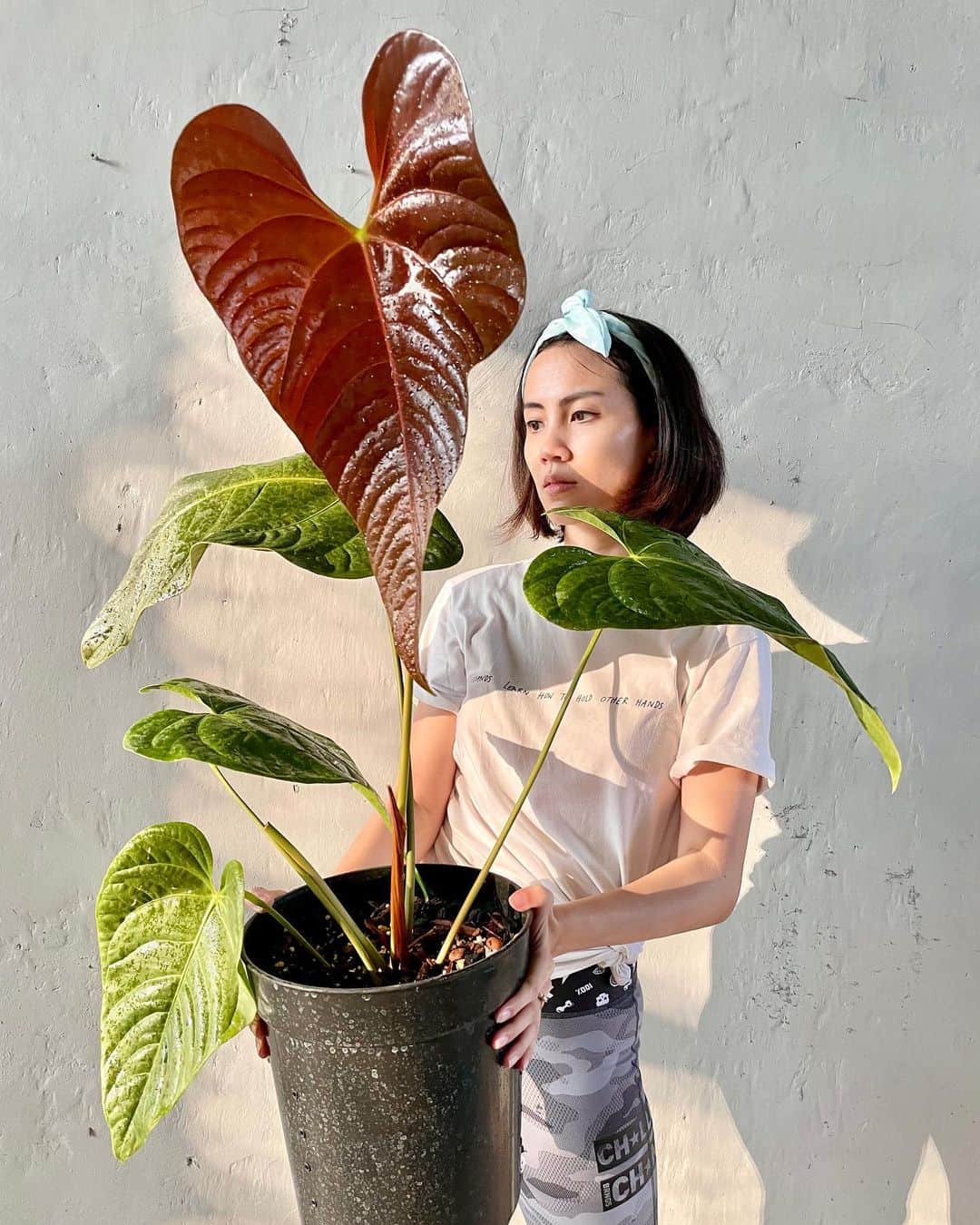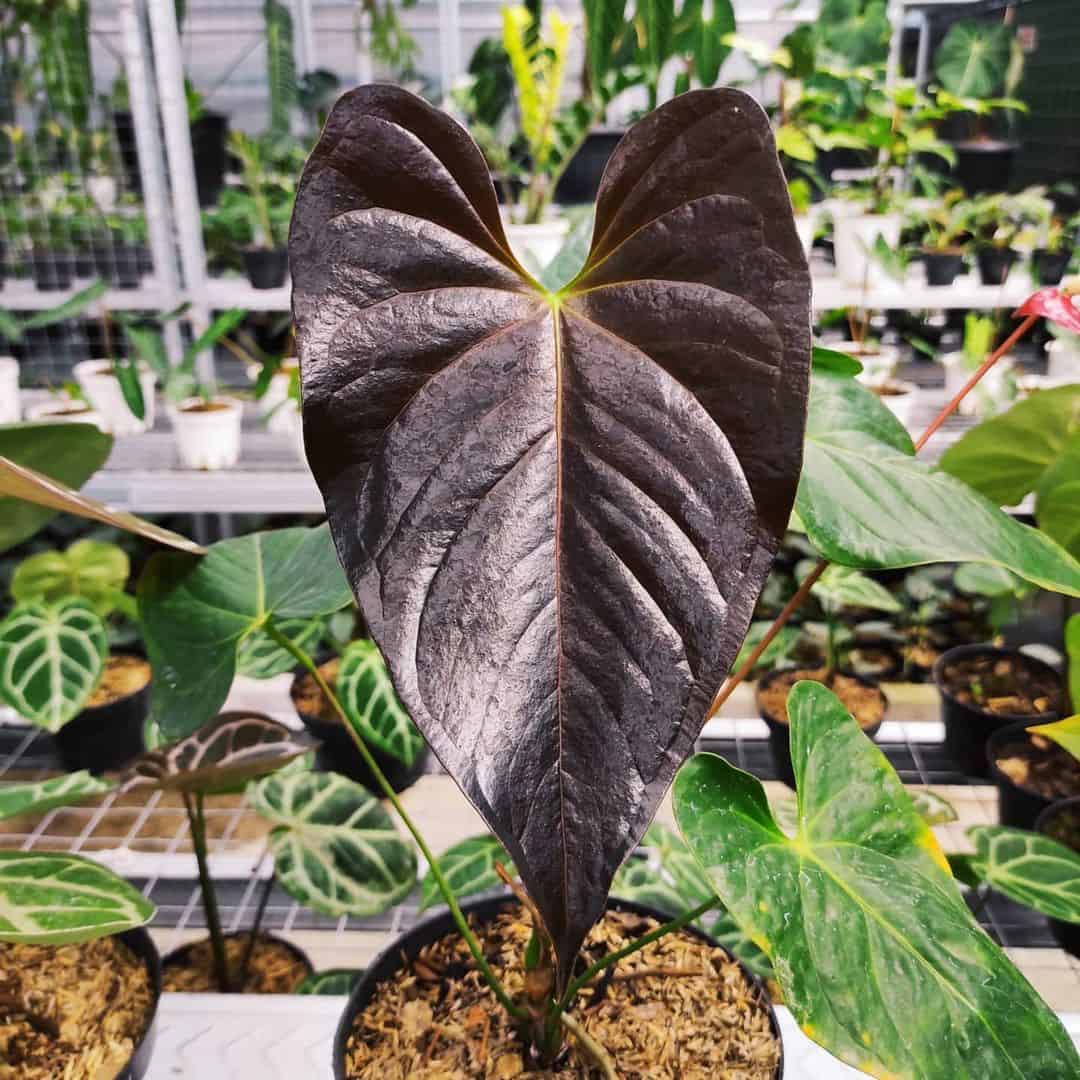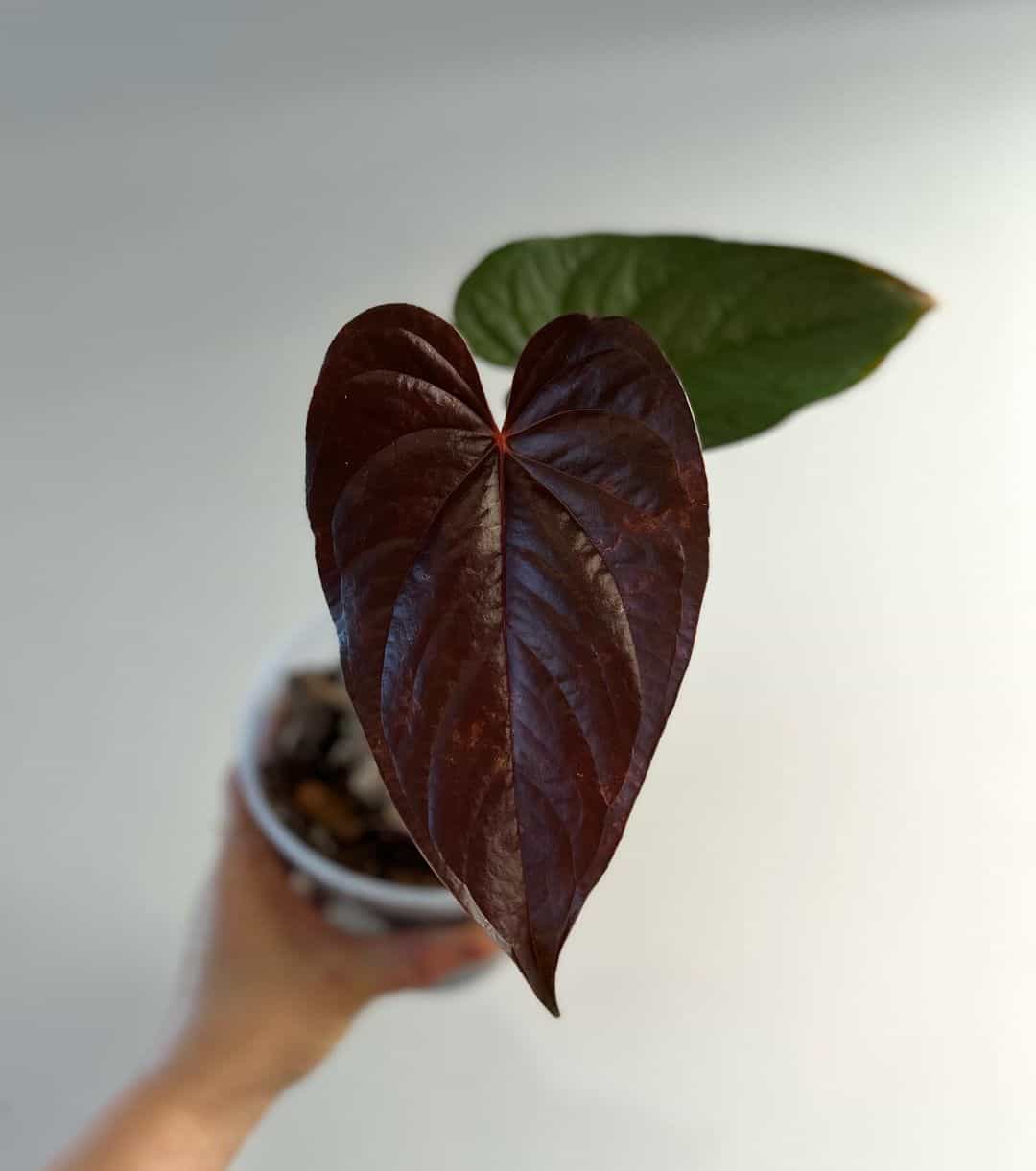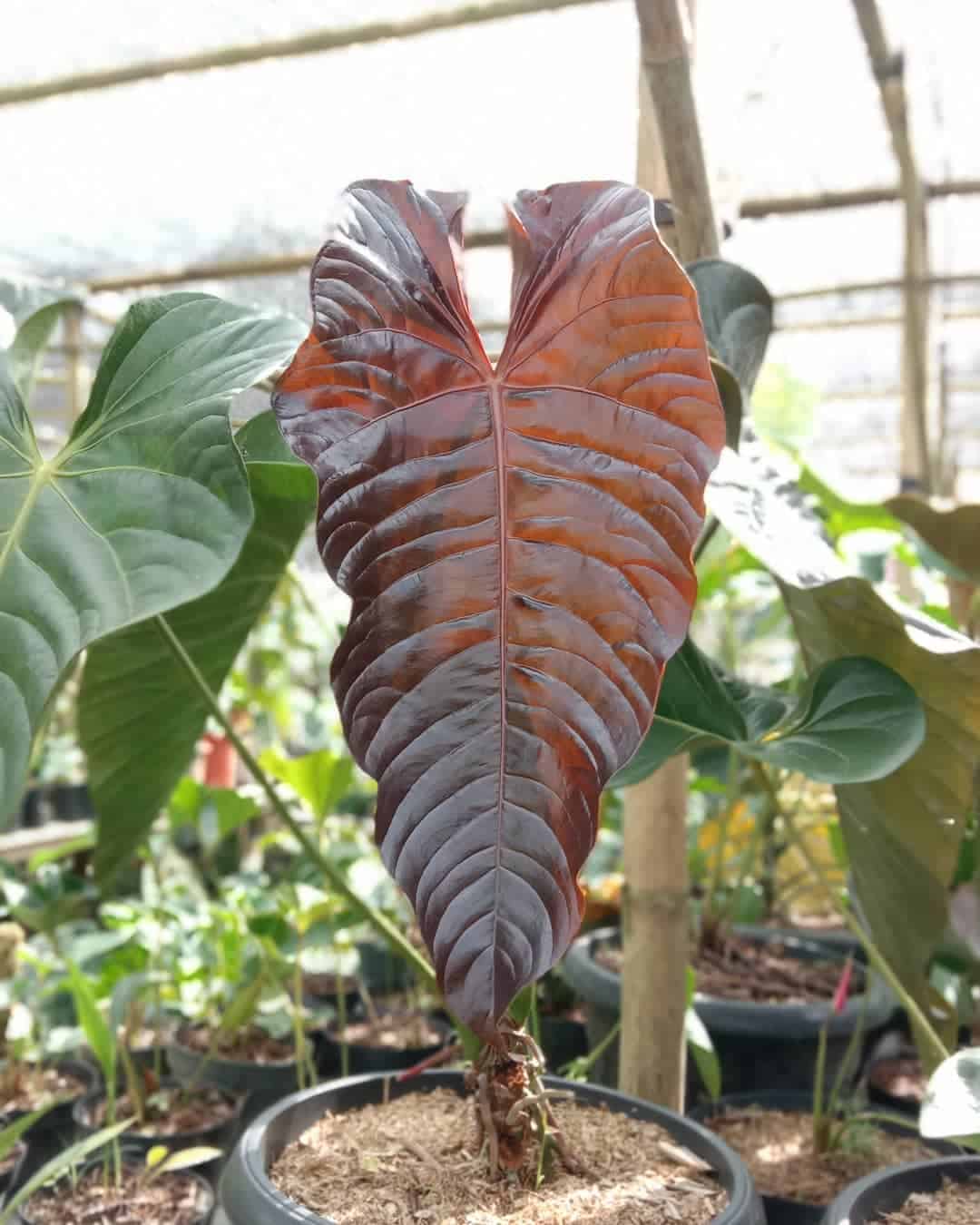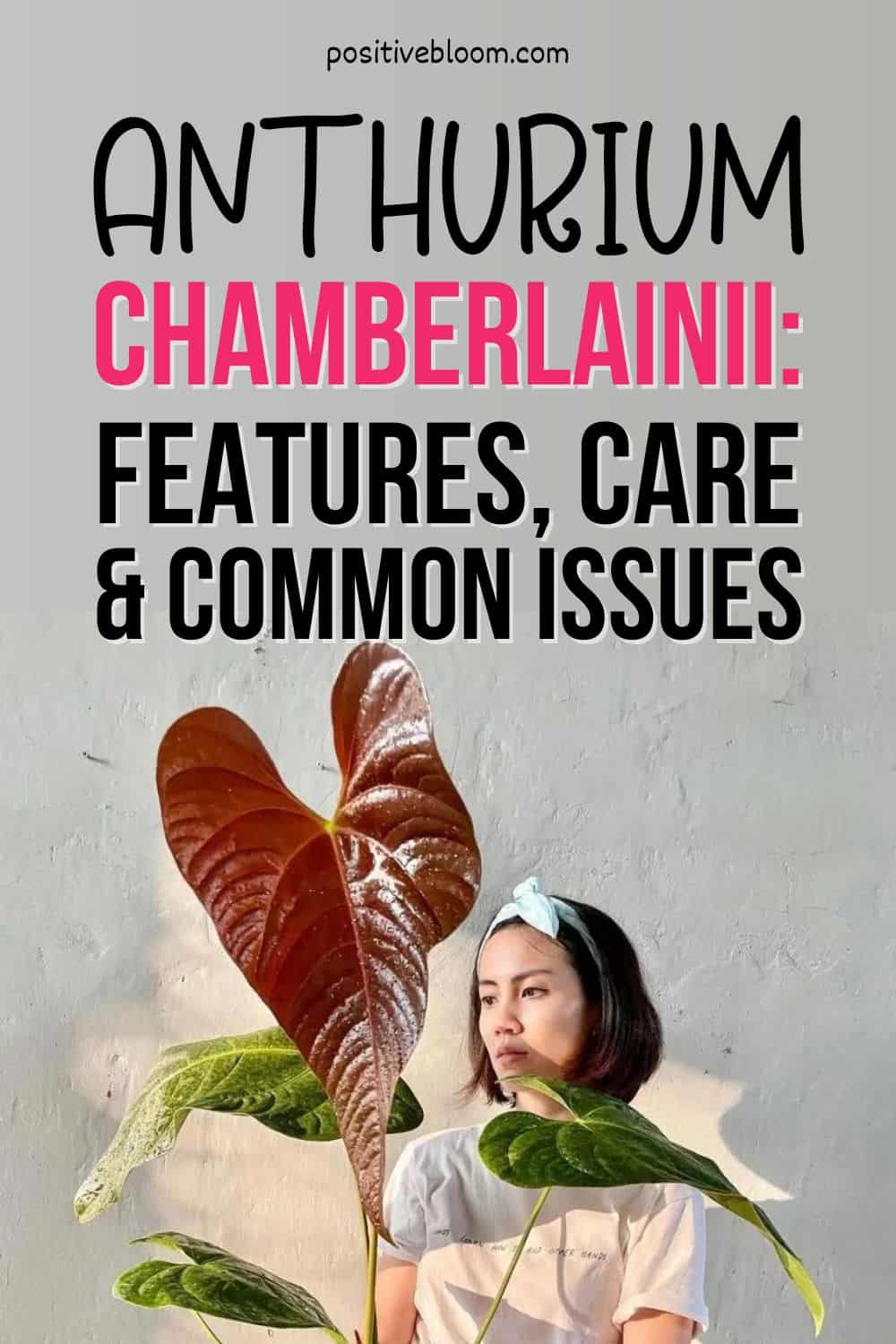The Anthurium genus has undoubtedly much to offer. Each Anthurium has different features, and the extraordinary appearance of these plants, combined with their easy growing, encourages growers to add at least one Anthurium to their own collection.
Now, I present to you one of the rarest and yet most beautiful Anthurium plants: the Anthurium Chamberlainii.
This exotic vine changes the colors of its leaves as it matures, which is one of the many fascinating features of these Anthurium species.
Before we move on, here’s some basic info.
[table id=111 /]What Does The Anthurium Chamberlainii Look Like?
Photo from: @plantdaddy.id
If I had to choose one word to describe this plant, it would be ‘breathtaking’.
Let’s see why!
Appearance
The best way to describe the beauty of this Anthurium is to mention its ability to change the color of its leaves. Yes, you got it right! The leaves have different colors in its juvenile and mature stages.
If you look at the leaves of the young Chamberlainii, you will notice that they are deep burgundy. I have to mention that this is a unique color of the plants’ leaves.
As time passes, the dark burgundy leaves gradually turn to dark green. Therefore, if you grow this plant from the earliest stages, you will have an experience to remember.
Additionally, its leaf blades are arrow-shaped, which makes this rare aroid spectacular.
I’m a passionate plant grower and have grown many beautiful plants, but this Anthurium immediately caught my eye.
Mature leaves can grow up to 40 inches in length and 30 inches in width. That’s another great thing about the leaves; you can enjoy their color even more as they are pretty large.
Growth
The Chamberlainii Mast plant has a moderate growth rate and can reach its average height in 2 to 3 years. This Anthurium plant can grow up to 5 ft.
I have to mention that you can also encourage its growth by ensuring the best conditions. Although its growth depends on many conditions, light is undoubtedly the most important.
I’ve made a detailed Flamingo plant care guide for you to learn how to encourage this plant to grow healthily and thrive.
Let’s see more!
Care Guide
Photo from: @floraayunusantara
The Chamberlainii isn’t a demanding plant; it’s native to the wet forests of Venezuela, and if you mimic such conditions at your home, this plant will thrive in no time.
Ensure partial shade, a warm temperature, and moderate humidity when growing a Chamberlainii as a houseplant.
Additionally, the plant appreciates well-draining soil, moderate watering, occasional pruning, and repotting. Luckily, it’s not a heavy feeder (I find this important as many forget to feed their plants from time to time). You can also propagate the plant to enrich your home decor.
Piece of cake, right?
Let’s dig deeper!
Light Requirements
The light is the number one requirement on the care guide list for a reason, as houseplants need sunlight for photosynthesis. If you want the Chamberlainii plant to grow healthily, pay great attention to its light level.
The plant grows on trees in the Montane rainforests, which means that the plant is protected from direct sunlight. The Rainforest canopy ensures the plant has enough light and, at the same time, protects it from sunburns.
Therefore, the Chamberlainii grows best in bright, indirect light. However, you can expose the plant to direct sun in the morning.
The same goes for low light. It may still grow well, but if it grows in low light for an extended period, the Chamberlainii will show you signs that something needs to be changed. Sooner or later, low light will stunt the growth of this plant, and additionally, it may produce fewer blooms.
You can choose between two locations to place the plant. The first one is near an east-facing window. The morning sun will wake up the plant, and the indirect light will keep the plant energized during the rest of the day.
If there’s the possibility that the midday sun can reach the plant, place sheer curtains on the window to achieve the best results.
On the other hand, if you want to place this plant somewhere else, the other option is a north-facing window. However, if you grow the Chamberlainii in colder climates, I don’t recommend this position.
Temperature Requirements
A Chamberlainii plant enjoys warmer temperatures. This plant grows best at temperatures ranging from 70 °F to 90 °F (these can be slightly lower at night).
The Chamberlainii Mast is frost-intolerant; if the temperature drops below 60 °F, this plant will struggle to grow, especially if the temperature keeps dropping. In the worst-case scenario, the frost kills the plant.
However, if you live in zones 11 – 12, the plant can grow healthily even outdoors. If there’s the slightest chance for frost, move the plant indoors.
Make sure to place the plant away from any heating sources like fireplaces and radiators. Like many other houseplants, the Chamberlainii despises temperature fluctuations, so avoid places near windows or doors that open and close often.
Humidity Requirements
This plant isn’t demanding when it comes to humidity; moderate works well. Keep the humidity at around 50%. However, a low humidity may affect the plant, so choose higher than average if you have to choose.
As the plant grows in areas with a high humidity, it’s better not to experiment and to grow the plant in higher humidity levels. A low humidity can affect the leaves, and they could lose their fantastic color (we don’t want that).
To increase the humidity, you have three options: expensive, cheap, and the most affordable (I’m sure you’ll choose this last one).
Here’s a list:
• Humidifier: This may be the easiest way to increase the humidity (probably not the most exciting one).
• Pebble tray: Put a saucer under the pot of the plant. Add pebbles and fill the saucer with water. Be careful when placing the pot. If the roots come in touch with water, it could cause root rot.
• Now, we come to the simplest way to increase the humidity. Place the plant near other houseplants, especially philodendrons. The majority of houseplants are tropical plants and enjoy high humidity. The humidity will spread evenly, and the plant will have company.
There’s one device you can use to measure humidity, a hygrometer; it’s a great choice if you aren’t sure about the humidity level at your home.
Soil
This Anthurium doesn’t withstand waterlogged or dry soil. This is why you must ensure it has a soil with a good drainage system and good water retention. Additionally, the soil has to be well aerated, meaning that the airspace within the soil shouldn’t be clogged.
First, let’s discuss the waterlogged soil. If the roots grow in standing water for too long, they are most likely to suffocate, and as a consequence, they will suffer from rot.
Dry soil is also a problem. Dry soil prevents the plant from uptaking nutrients which can cause drooping leaves and plant wilting in general.
If the air spaces in the soil are clogged, the roots aren’t able to breathe. Consequently, the entire plant suffers, showing signs of wilting.
The soil for this plant should have a pH ranging from 5.5 to 6.5.
When choosing a potting mix, avoid regular soil as it’s compact and this plant prefers loose.
You can choose between three options. First, you can purchase an aroid mix that is designed for Anthuriums.
The second option is the DIY version. Add perlite, peat, and pine bark. Make sure you put in an equal amount of each ingredient. Perlite improves drainage, peat retains water, and pine bark keeps the soil well aerated.
And the last option, you can use an orchid potting mix. Most mixes designed for orchids contain higher amounts of peat, and therefore, they might retain water more than the Chamberlainii needs. If you purchase an orchid mix, I suggest adding some sand to the mix to improve its drainage. First, add a small amount to see how the soil responds and then increase to a handful.
Watering
Photo from: @le__petitjardin
During the summer, you should water a Chamberlainii once a week approximately. However, this schedule will work well only if all the other care guide conditions are provided.
For example, if the plant is placed in more sunlight, the watering should be more frequent. Additionally, if the weather is warm, the soil will dry out fast, again water more frequently.
Be careful to water less if the humidity is high. The soil will be well moisturized and won’t need much water.
Therefore, don’t worry if you water the plant every ten days or every two days. What’s essential is healthy growth.
The Chamberlainii plant needs to be watered every two days in warmer climates, and it’s impossible to get overwatered.
The things to remember are, water more in summer and water less in winter. You can water every two weeks, approximately during winter. A similar watering schedule works for Alocasias; if you grow one already, it will be easier to care for a Chamberlainii.
When you water this Anthurium plant, give it a good soak, meaning soak the entire root system until you see water coming out from the drainage holes. You should allow the soil to dry entirely between the watering.
There’s one more method for watering. You can water the plant from the bottom. Fill a container with water and place the plant’s soil in it.
The soil will absorb enough moisture. I suggest you use this method if you have enough time to monitor the pot, but also if you’re a beginner.
Fertilizing
The great thing about the Chamberlainii is that it will grow healthily even if not fed often. You can apply fertilizer every two to three months.
However, you can’t skip fertilizing totally. If you skip feeding, the low levels of plant nutrients could cause the Chamberlainii plant to grow slower and produce fewer flowers (we don’t want that).
I suggest you use balanced liquid houseplant 20-20-20 or 19-19-19 fertilizer. I always dilute it to half strength. Be careful to water the plant before you add fertilizer.
The lower concentration of chemicals means that the roots will receive less harmful salts.
You can also use organic fertilizers for this Anthurium. For example, you can add a layer of vermicompost to promote growth.
Pruning & Grooming
The Chamberlainii is not demanding when it comes to pruning. Pruning is required if there are yellow or dead leaves.
Additionally, you can prune the plant to achieve more growth, but I wouldn’t suggest this if you are a beginner. If you prune from the center, keep in mind that the young stems are placed in the center and will be leaf bearers in the upcoming days. If you touch them, the plant will instantly die.
Always sterilize your pruning tools as you don’t want any infectious disease to spread onto the other parts of the plant. I use rubbing alcohol or bleach.
Propagation By Stem Cuttings
Chamberlainii can be propagated by stem cuttings. You should take the cuttings and propagate them in the early spring. If you take the cutting during blooming, it can kill the plant.
When you propagate during early spring, the cutting will have the entire growing season to grow, and the new plant will be established until winter. The plant stops growing during the winter, and your new plant will have enough time to take a well-deserved rest.
There are two options for the cuttings: place them in soil or water.
Both processes have the first two steps in common.
• First, you should select a stem to cut. It needs to be healthy and have two nodes and a few leaves attached. If there’s a stem with aerial roots, cut that one, as it will give the best results.
• Sterilize either garden shears, a pair of scissors, or a knife. No matter which one you use, make sure it’s sharp. The cutting should be 4-6 inches long below the node. If it has an aerial root, cut the stem below it.
Stem Cuttings In Soil
After you’ve made the cuttings, it’s time to provide the medium for the growth of the new plant. Here’s how.
• Put the potting mix in a container.
• Poke a hole in the center of the soil and bury the cutting with nodes about 4 inches down. The aerial roots should be above the soil.
• Gently press the soil around the cutting to stand firm and upright.
• Water the soil when you notice that it’s dry 2 inches below the surface. Keep the soil moist until you can see the roots.
• You can expect the roots to sprout in 3 to 6 weeks. You will know that the roots are ready for transplant if you tug on the stem and there’s resistance.
Stem Cuttings In Water
After taking the cuttings, follow the steps below if you decide to propagate in water.
• Fill a jar with water.
• Place the cutting in the jar. The nodes and aerial roots should be submerged in the water.
• The leaves shouldn’t be in the water; remove the leaves touching the water.
• Change the water regularly.
• You can expect the roots to sprout in 3 to 6 weeks. The roots are ready if they’re white and about 2 inches long.
Place the roots in new potting soil in the original pot.
Repotting
The Chamberlainii plant has a moderate growth rate; you can repot it every 2 years, depending on the size.
There are two reasons to repot a Chamberlainii. The first one is when the plant outgrows the pot, you’ll notice the roots coming out of the drainage holes when this happens.
Another reason is when the plant gets root bound. The roots will wrap around the ball and stunt the plant’s growth.
Choose a slightly larger pot, approximately 2 inches larger in diameter than the previous one, when repotting.
I suggest that you use fresh soil each time you repot to avoid potential infectious diseases.
Choose spring or early summer for repotting.
Here’s a video on how to care for Chamberlainii:
Common Issues
Photo from: @ahmad_gena_ari
The A.Chamberlainii and other Anthuriums are prone to bacterial and fungal diseases. The most common cause of these diseases is overwatering.
Some pests can also occur and should be removed as soon as possible.
Bacterial Blight
Bacterial blight is caused by one of the species of Xanthomonas bacteria. If your plant suffers from bacterial blight, you will notice yellow lesions along the edges of the leaves.
The first way that this plant can get this disease is by pruning it with unsterilized tools. You are creating wounds on the plant, an entry point for these bacteria. If you overwater the plant, the bacteria will quickly spread to the entire plant.
Remove the affected leaves and let the other leaves dry out completely before continuing with the usual care.
Root Rot
Root rot is another consequence of overwatering. When the soil is waterlogged, it attracts the fungus Rhizoctonia which causes root rot. If your Chamberlainii suffers from root rot, it will have mushy soil with an unpleasant smell. You will notice yellow and soft leaves.
The unhealthy roots will be mushy and black or brown. If you suspect that your plant suffers from root rot, take it out of the pot. Inspect the root system, apply fungicide and remove the damaged roots with sterilized scissors.
Repot the plant and be careful when watering.
Wilting
There are many reasons for wilting. First, you may have underwatered your plant, and the leaves will turn brown or have brown and crispy edges. Give the plant a good soak and water more frequently until you notice signs of improvement. Continue with the usual watering schedule afterwards.
Another reason is the bacteria Ralstonia, which spreads in higher temperatures.
Always sterilize any tool you use before handling the plant.
Pests
The Chamberlainii Mast isn’t prone to pests. If you ensure everything the plant needs and clean the leaves regularly, there’s no reason to worry about pests.
However, these annoying creatures can just show up to ruin the party. The most common pests that affect a Chamberlainii are aphids, mealybugs, spider mites, and scales.
Fill a spray bottle with water and spray over the pests until they’re gone. You can also rub the leaves with neem oil.
Toxicity
The A.Chamberlainii is a toxic plant. Calcium oxalate crystals are present in the leaves, and when ingested, the leaves release the crystals.
A Chamberlainii plant is toxic to both humans and pets.
Therefore, make sure to keep the plant away from small children and pets.
If they consume the leaves, they could get mouth-swelling or diarrhea.
The Story Behind The Anthurium Chamberlainii
Photo from: @kerlanggadeo
I mentioned in the article that you’re lucky if you get this plant. I have to say that the Anthurium Chamberlainii and Anthurium Moodeanum aren’t available in the plant stores, and these are endangered species.
Can you believe that many thought that the Chamberlainii became extinct in the 19th century?
In 2013, the plant was rediscovered. In the article Anthurium chamberlainii Masters published in Gard, Chron, the authors Gröeger and Croat describe the plant they discovered to have spathe and spadix, with inflorescence on the upper right open and young inflorescence on the lower left open.
They concluded that this rare plant was the lost Anthurium Chamberlainii.
You’re wondering why they don’t just propagate the plant. Well, you aren’t allowed to touch the plant. Any issue can destroy the plant, and we might lose it forever.
Is Anthurium A Lucky Plant?
If the situation changes in the future, if this Anthurium becomes more available, you should know one more thing about it.
It’s a lucky plant, and according to Feng Shui, it brings luck to your relationship.
If you get the chance to grow Chamberlainii, get an Anthurium Luxurians, too. It will bring you double luck.
Wrapping Up
I can only say that we had luck when we rediscovered the Anthurium Chamberlainii.
This rare and exotic Anthurium species deserves to be a topic in each plant grower’s discussion.
I’m sure that after reading this article, you are wondering who wouldn’t want to grow this fascinating plant? I’m sure everyone would, except those who can’t find one or those with young children and pets.
Until next time!
Like this post? Share or pin it for later!

